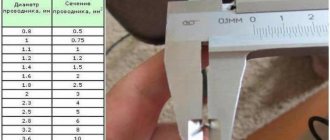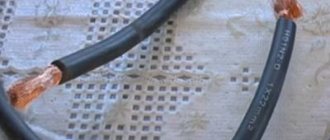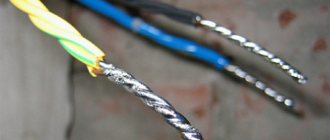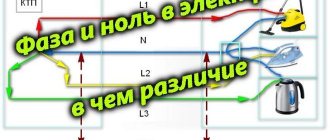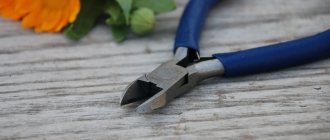In this article we will understand the concept of “sectional area” and analyze reference data. The choice of cross-sectional area of wires (in other words, thickness) is given much attention in practice and in theory. After all, the resistance of 1 meter of wire depends on the cross-sectional area, which means the maximum current, limited by the heating temperature, and the voltage drop in this section of the wire.
General information about cable and wire
When working with conductors, it is necessary to understand their designation.
There are wires and cables that differ from each other in their internal structure and technical characteristics. However, many people often confuse these concepts. A wire is a conductor that has in its design one wire or a group of wires woven together and a thin common insulating layer. A cable is a core or a group of cores that has both its own insulation and a common insulating layer (sheath). Each type of conductor will have its own methods for determining cross sections, which are almost similar.
Application area
The circle is one of the fundamental figures that surround a person everywhere. Pipes, wheels, lamps, stove burners - all of this has the shape of a circle or a cross section in the form of a circle. Calculating the area of such a section may be necessary in the following situations:
- Determination of container volumes.
- Solving problems in strength of materials and electrical engineering.
- Calculation of the amount of materials during design, construction and repair.
- Conducting irrigated agriculture.
Conductor materials
The amount of energy that a conductor transmits depends on a number of factors, the main one of which is the material of the current-carrying conductors. The following non-ferrous metals can be used as the core material of wires and cables:
- Aluminum. Cheap and lightweight conductors, which is their advantage. They are characterized by such negative qualities as low electrical conductivity, a tendency to mechanical damage, high transient electrical resistance of oxidized surfaces;
- Copper. The most popular conductors, which have a high cost compared to other options. However, they are characterized by low electrical and transition resistance at the contacts, fairly high elasticity and strength, and ease of soldering and welding;
- Aluminum copper. Cable products with aluminum cores coated with copper. They are characterized by slightly lower electrical conductivity than their copper counterparts. They are also characterized by lightness, average resistance and relative cheapness.
Some methods for determining the cross-section of cables and wires will depend specifically on the material of their conductor component, which directly affects the throughput power and current strength (method of determining the cross-section of conductors by power and current).
Tips from an electrician
If you are selecting a VVGNG wire or cable to power the electrical network, pay attention to the following points:
- Look at the color of the copper and aluminum wire, as the manufacturer could save money and use an alloy, which significantly increases the electrical resistance and does not allow the use of permissible cross-sectional loads.
- No matter how thin the insulation of a flexible cable is, to calculate the cross-section you still need to measure only the core. Since the extra millimeters will allow you to use a wire with a smaller cross-section to power an excessive load, and this is fraught with damage.
- If at some stage you doubt the sufficiency of the cross-section or realize that using devices of lower power will not work, it is better to mount the wiring with a thicker wire.
Features of electrical wires
With all the variety of cable products and a huge selection of wires for laying electrical networks, there are selection rules. It is not necessary to memorize all brands of cables and wires; you need to be able to read and decipher their markings. First, it’s worth figuring out the difference between a wire and a cable.
Wire – A conductor used to connect two sections of a circuit. May have one or more conductive wires. The veins can be:
- naked;
- isolated;
- single-core;
- stranded.
Bare lines are used where touching live wires is impossible. In most cases they are used for overhead power lines.
The insulating coating is used in one or two layers. Wires that have two or three conductors in double insulation are confused with a cable. The confusion occurs due to the fact that insulation covers each core, and on the outside there is a general polymer or other coating. Such conductors are used inside electrical devices, panels or cabinets. In everyday life, they are hidden in the wall or laid in special channels.
Insulated products are used everywhere. Depending on the degree of electrical safety of the room and the installation location, the insulation class is selected.
Stranded conductors are used where small radius bends are required when laying complex routes where single-core analogues cannot pass. This type of current conductors is convenient to install in cable ducts. Single-core wires are more difficult to bend in such conditions, force must be applied, and there is a risk of damage to the wire.
For your information. Marking APPV 3*2.5 means a wire with aluminum conductors, polyvinyl chloride insulation, flat, having a dividing base. The meaning of the marking is clarified in the reference literature.
In terms of structure, a cable consists of several individually insulated strands placed in a protective outer layer of dielectric material. The space between the cores and the shell is filled with paper tapes, plastic threads or cable yarn to prevent sticking. Additionally, the product can be reinforced with armor made of tapes or steel braiding to protect against mechanical damage.
Why does the discrepancy occur?
Despite the fact that in the conditions of modern competition, manufacturers are doing their best not to lose their customers, some of them resort to deception. To do this, they save metal by reducing the diameter. It is enough to remove just a couple of square millimeters, and over hundreds of kilometers of cable this will pay off with a significant reduction in cost.
And then the price will be reduced for the buyer, and they themselves will be satisfied. But the consumer ultimately puts himself at risk due to the fact that the conductor resistance is much lower than stated. And in the place where such a wire is laid, there is a risk of fire.
Conductor cross-sectional area
Calculation of voltage drop in a cable. In drawings, a section is an image of a figure formed by cutting a part with a plane. What is a cross section in electrical engineering? Applicable to electricity, considers the cross-section of a conductor at right angles to its longitudinal side. The cross-section of the core through which electrons pass is a circle and is measured in mm2. Important! The diameter of the core is often confused with its cross-section. To find out what cross-section the wire has, you need to determine the area of the resulting circle by calculating it using the formula.
Conductor cross section
Since the cross-section of the wire is a circle, the area is calculated using the formula:
S cr = π*R2, where:
- S cr. – area of the circle, mm2;
- π = 3.14;
- R – radius of the circle, mm.
Knowing the cross-sectional area of the core, its length and the resistivity of the material from which it is made, it is possible to calculate the resistance of the conductor to the electric current flowing through it.
Information. Considering that the radius is equal to 1/2 the diameter, the formula can be transformed for ease of use. It will look like Skr = π*D2/4 = 0.8 * D2. To calculate the cross-sectional area of a conductor, the diameter value is often used. An incorrectly selected wire diameter causes it to overheat and melt, which, in turn, can cause a fire in the electrical wiring.
Tensile strength and tensile elongation
When choosing wires, in addition to the cross-section, wire material, and insulation, it is necessary to take into account their mechanical strength. This is especially true for overhead power lines. The wires are stretched. Under the influence of force applied to the material, the latter elongates. If we denote the initial length as l1 and the final length as l2, then the difference l1 – l2 = Δl will be the absolute elongation.
Attitude
called relative elongation.
The force that produces a rupture of a material is called the breaking load, and the ratio of this load to the cross-sectional area of the material at the moment of destruction is called the temporary tensile strength and is denoted
Data on tensile strengths for various materials are given below.
Tensile strength value for various metals
| Name of metal | Tensile strength, kg/mm² |
| Aluminum Aldrey Bronze Tungsten Gold Brass Copper Molybdenum Nickel Tin Platinum Mercury Steel Silver Lead Zinc Cast Iron | 8 – 25 30 – 38 31 – 135 100 – 300 – 30 – 70 27 – 44,9 80 – 250 40 – 70 2 – 5 15 – 35 – 70 – 75 15 – 30 0,95 – 2,0 14 – 29 12 – 32 |
Dependence of current, power and core cross-section
It is not enough to measure and calculate the cross-sectional area of the cable based on the diameter of the core. Before installing wiring or other types of electrical networks, it is also necessary to know the capacity of the cable products.
- When choosing a cable, you must be guided by several criteria:
- the strength of the electric current that the cable will pass;
- consumer power;
- current load exerted on the cable.
Power
The most important parameter during electrical installation work (in particular, cable laying) is throughput. The maximum power of electricity transmitted through it depends on the cross-section of the conductor. Therefore, it is extremely important to know the total power of the energy consumption sources that will be connected to the wire. Typically, manufacturers of household appliances, appliances and other electrical products indicate on the label and in the documentation accompanying them the maximum and average power consumption.
For example, a washing machine can consume electricity ranging from tens of W/h during rinsing mode to 2.7 kW/h when heating water.
Accordingly, a wire with a cross-section that is sufficient to transmit electricity of maximum power must be connected to it. If two or more consumers are connected to the cable, then the total power is determined by adding the limit values of each of them. The average power of all electrical appliances and lighting devices in an apartment rarely exceeds 7500 W for a single-phase network. Accordingly, the cable cross-sections in the electrical wiring must be selected to this value.
It is recommended to round the cross-section towards higher power due to a possible increase in power consumption in the future. Typically, the next largest cross-sectional area from the calculated value is taken. So, for a total power of 7.5 kW, it is necessary to use a copper cable with a core cross-section of 4 mm2, which is capable of transmitting about 8.3 kW. The cross-section of the conductor with an aluminum core in this case must be at least 6 mm2, passing a current power of 7.9 kW.
Features of self-calculation
Independent calculation of the longitudinal section is performed on a core without an insulating coating. A piece of insulation can be moved or removed on a piece purchased specifically for testing. First you need to determine the diameter and find the cross section using it. Several methods are used for the work.
Using a caliper
The method is justified if the parameters of a truncated or defective cable are measured. For example, VVG may be designated as 3x2.5, but in fact be 3x21. Calculations are made as follows:
- The insulating coating is removed from the conductor.
- The diameter is measured with a caliper. You will need to place the wire between the legs of the instrument and look at the scale markings. The integer value is on top, the decimal value is on the bottom.
- Based on the formula for finding the area of a circle S = π (D/2)2 or its simplified version S = 0.8 D², the cross section is determined.
- The diameter is 1.78 mm. Substituting the value into the expression and rounding the result to hundredths, we get 2.79 mm2.
For domestic purposes, you will need conductors with a cross section of 0.75; 1.5; 2.5 and 4 mm2.
Using a ruler and pencil
Calculation of PS using a ruler and pencil.
If you don't have a special meter, you can use a pencil and ruler. Operations are performed with the test image:
- An area of 5-10 cm is cleared of the insulating layer.
- The resulting wire is wound around a pencil. Full turns are laid tightly, there should be no space between them, the “tails” are directed up or down.
- Ultimately, a certain number of turns should be obtained; they need to be counted.
- The winding is applied to the ruler so that the zero division coincides with the first winding.
- The length of the segment is measured and divided by the number of turns. The resulting value is the diameter.
- For example, it turned out 11 turns, which occupy 7.5 mm. When dividing 7.5 by 11, 0.68 mm is the cable diameter. The cross section can be found using the formula.
The accuracy of the calculations is determined by the density and length of the winding.
Simplifications
Images (types, sections, sections) can be simplified to make them easier to understand. Standards and norms regulate this process.
For symmetrical figures, it is allowed to draw only one half of the cut or most of it, drawing a break line. When an object has several identical elements, only one of them is drawn. The remaining identical parts are drawn schematically.
Projections of intersection lines may be depicted in a simplified manner. But only if their detailed image is not required.
When drawing simple figures, for example, if you need to consider the types of sections of a cone, you use a certain approach to graphics. This makes the drawings easier to understand. When one surface changes in a particular pattern, it can be interrupted.
If one surface smoothly passes into another, their boundary is not indicated or is indicated conditionally.
Non-hollow symmetrical parts and products in the drawing are shown uncut in a longitudinal section. And if the size of a part of the product in the drawing is less than 2 mm, it is depicted with a deviation from the main scale.
To indicate flat surfaces, diagonals can be drawn with solid lines.
It should also be taken into account that permanent connections of electrical or radio devices are simplified by standards corresponding to the type of product. These are the main simplifications that are regulated by the Unified System of Design Documentation. They are most often used to create drawings in large industries, where it is necessary to depict complex parts, assemblies or mechanisms.
Methods for determining wire cross-section step by step
There are several ways to measure the cross-section by core diameter. If the wire is single-core, then measurements will be made immediately on it, but one conductor must be untangled from the cable coil. After this, it is cleared of insulation so that only metal remains.
To calculate the area of a circle through the radius, use the formula: S = π × R2, where:
- π – constant equal to 3.14;
- R is the radius of the circle.
But, due to the fact that from a practical point of view it is much easier to calculate a diameter equal to two radii, the calculation formula will take the following form: S = π × (D/2)2. Depending on the methods for measuring the diameter, such methods for calculating the cross section are distinguished.
By diameter using a caliper or micrometer
The most relevant option to measure the diameter are instruments such as calipers and micrometers. These devices allow you to measure the diameter as accurately as possible. To do this you will need a wire and a micrometer.
To do this, latch B is moved to the open position. The micrometer handle is unscrewed to such a distance that the wire easily fits in the space between probes A. Then, using handle G, the device is twisted until the ratchet operates. After this, readings are recorded on all three scales at point B.
In this example, the diameter is 1.4 mm, therefore, to calculate the cross-section, you need S = 3.14 × 1.4 × 1.4 / 4 = 1.53 mm². The same procedure for determining the cross section can be performed using a caliper. The advantage of this method is the ability to measure any round conductor, even if it is already installed and used to power any electrical device. The main disadvantage of the method is the high cost of the devices; naturally, purchasing them for a couple of measurements is completely impractical.
By diameter using a pencil or pen
This method of determining the cross-section is based on the fact that the wire has the same diameter along its entire length. Take a regular pencil, pen or felt-tip pen and wrap the wire around it in a spiral. To eliminate the thickness of the insulation, it must be cut along its entire length. The rings should be placed as tightly as possible; the larger the space between the rings, the lower the accuracy.
Since all wires have the same thickness, to determine the diameter of the copper wires, measure the length of the entire winding and divide by the number of turns. In this example, D = 15 mm / 15 turns = 1 mm, respectively, using the same calculation formula, we obtain a section S = 3.14 × 1 × 1 / 4 = 0.78 mm². Note that the more turns you make, the more accurately you determine the cross-section.
It is worth noting that the advantage of this method is that only available means can be used to determine the cross-section. The disadvantage is low accuracy and the ability to wind only thin conductors. In the example, a relatively thin wire was used, but the distance between the turns is already visible. Because of which the accuracy leaves much to be desired, it goes without saying that aluminum wire cannot be bent in this way.
By diameter using a ruler
Let’s immediately make a reservation that for measuring with a ruler you can only take a relatively thick wire; the smaller the thickness, the lower the accuracy. The diameter of the vein can be determined by thread or paper; the second option is the most preferable, as it gives greater accuracy.
Tear off a small strip and fold it over on one side. Thinner paper is preferable, so there is no need to fold the sheet several times. Then the paper is applied to the wire and wrapped around the circumference until the strip touches. At the point of contact, it is bent a second time and applied to the ruler for measurement.
Using the resulting circumference L, the vein diameter D = L / 2 π is found, and the cross section is calculated as shown earlier. This method of determining the cross-section is well suited for large aluminum conductors. But the accuracy in this method is the lowest.
By diameter using ready-made tables
This method is suitable for standard gauge wires. For example, you have already determined the diameter using one of the above methods. Then you use the table to determine the section.
Table 1: determination of cross section based on wire diameter:
Some special cases of simplifications
If the drawing shows sections, sections, views for regularly changing surfaces, they can be broken. This is done in a certain way. There are three restriction options.
The first type involves using a solid thin broken line. It can extend beyond the image border by 2-4 mm. Also, the outline of parts of a part can be connected by a solid wavy line or hatching.
To simplify the drawing, it is allowed to cut with a dotted line between the cutting plane and the observer. Complex slices are also used to improve understanding of graphics.
When depicting the holes of some parts (gear hubs, keyways, pulleys), only their outline is given. If the recess located on the round flange does not fall into the cutting plane, it is depicted in a section.
If there is an ornament or a continuous mesh on a part, it is allowed to depict only a small part of it or to simplify the elements of the design.
Such methods allow you to achieve purity of the drawing and make it easier to understand. After all, the use of engineering graphics to create all kinds of objects implies the use of a single symbolic language. Every specialist whose work involves this type of image should know it. The quality of the final result depends on this.
Having studied the types of sections, you can understand the basic principles of their implementation and understanding. By applying the recommendations of the standards, you can achieve good cleanliness of the drawing. This makes the process of its interpretation easier. Understanding the difference between view, section and section, knowing their classifications and the technology for correct drawing, a specialist can create the correct image. It can be easily understood by the technician who produces the workpiece or finished product, and will be able to create units and parts that meet all the requirements. The quality of the entire production depends on this process.
Determining the wire cross-section of outlet lines
When determining the wire diameter for room wiring, consider the maximum load of consumers that can be turned on at the same time. Based on this power, the cross-section of the main lines that go from the meter and input circuit breakers to the distribution boxes is selected. These are the areas that will bear the total load of all connected consumers. Choose a wire with copper conductors of at least 6 mm2.
Branch conductors from distribution boxes to sockets are selected individually for each room. This takes into account household electrical appliances that can be connected to an outlet. The cross-section of the cores is selected with a margin of one order of magnitude. This is in case there is a need to power some kind of construction tool from an outlet: a hammer drill, a welding inverter.
If the total power of consumers in the room is 4 kW, then the conductor with a copper core feeding the outlet should have a cross-section of 2.5 mm².
Attention! The cross-section of the conductor must allow it to withstand the current load and not overheat during operation of household appliances. In practice, the device with the highest power is determined and the appropriate wire diameter is selected relative to the characteristics of the device.
As a result, it turns out that the outlet conductor with copper conductors for each socket will have a cross-section of 2.5 mm2. The main wire for wiring is taken with a cross-section of 6 mm². It should be taken into account that the entire electrical wiring circuit is carried out with wires having cores of the same material. Copper and aluminum strands cannot be twisted together.
Geometric bodies. Cylinder.
A cylinder is a geometric body that is limited by a cylindrical surface and 2 planes that are parallel and intersect it.
ABCDEFG and abcdefg are the bases of the cylinder . The distance between the bases (KM) is the height of the cylinder .
Cylindrical sections of the lateral surface of a circular cylinder .
Sections that run parallel to the base will be circles of the same radius. The sections that are parallel to the generators of the cylinder are pairs of parallel lines (AB || CD). Sections that are not parallel to either the base or the generators are ellipses.
A cylindrical surface is formed by moving a straight line parallel to itself. The point of the line that is selected moves along a given flat curve - guide . This straight line is called the generator of the cylindrical surface .
A straight cylinder is a cylinder in which the generators are perpendicular to the base. If the generators of the cylinder are not perpendicular to the base, then it will be an inclined cylinder .
A circular cylinder is a cylinder whose base is a circle.
A circular cylinder is a cylinder that is both straight and circular.
A right circular cylinder is determined by the radius of the base R and the generatrix L, which is equal to the height of the cylinder H.
A prism is a special case of a cylinder.
Tables for selecting a suitable conductor
A convenient and practical option for selecting the desired wire (cable) is to use special tables that indicate the diameters and cross-sections relative to the power and/or currents carried.
Having such a table at hand is an easy and simple way to quickly determine the conductor for the required electrical installation. Determining the required values using a classic table is one of the most convenient ways to select the required conductor during installation work. Considering that traditional conductors for electrical installations are products with copper or aluminum conductors, there are tables for both types of metals.
Also, tabular data often presents values for voltages of 220 volts and 380 volts. Plus, the installation conditions are taken into account - closed or open wiring. In fact, it turns out that one sheet of paper or a picture loaded into a smartphone contains voluminous technical information that allows you to do without the above-mentioned mathematical (linear) calculations.
Moreover, many manufacturers of cable products, in order to make it easier for the buyer to choose the right conductor, for example, for installing sockets, offer a table in which all the necessary values are entered. All that remains is to determine what load is planned for a specific electrical point and how the installation will be performed, and based on this information, select the correct wire with copper or aluminum conductors.
How to determine whether the parameters match?
As a rule, extreme care on your part allows you to avoid such incidents during the purchase:
- A normal wire must have its marking, which provides the buyer with all the information about the model, operating features, and parameters. If you encounter questionable products, you may find that the product data is not presented in full or is completely missing.
- If the conductor is really good, he must be provided with quality certificates. The technical documentation indicates that it was not only manufactured in accordance with the ND, but also passed the appropriate tests.
- A good wire cannot cost a penny - since the price of materials is quite high, the cheapness should make you wonder if there is some kind of catch in this. If you wish, you can come to the store with a micrometer or caliper and perform a test to clear your doubts.
Which cable to choose for apartment wiring
Despite the cheapness of aluminum conductors, it is better to avoid using them. The reason is the low reliability of the contacts through which currents will pass. The second reason is the mismatch of the wire cross-section with the power of modern household appliances. Copper cable is reliable and has a long service life.
In apartments and houses it is allowed to use wire marked:
- PUNP is a flat conductor with copper conductors in a PVC sheath. Designed for a nominal voltage of 250 V at a frequency of 50 Hz.
- VVG/VVGng – flat cables made of copper with double PVC coating. They are used inside and outside buildings and are not subject to fire. They come with 2, 3 and 4 cores.
- NYM - copper wire for internal single line. It has an insulating PVC sheath and outer covering, conductors with and without grounding.
When choosing the number of cores, you will need to take into account the conductivity per unit cross-section. In this case, it is better to make the apartment network from a single-core wire, the thickness of which is greater. Multicore elements can be bent many times and electrical appliances can be connected to them. Only a cable with thin cores will be of high quality.
The correct cross-section of conductors, taking into account the power of the equipment and the type of network are important factors when organizing an electrical line. The cable diameter can be calculated independently in several ways. Based on these readings, it is easy to determine the cross-section of the cores using formulas or using a table.
